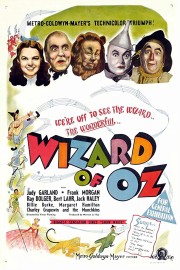The Wizard of Oz
In 1998, I had the profound pleasure to see many established “classic” films on the big-screen, thanks to re-releases and special festivals. Nowadays, such opportunities are a thing of the past, reserved for either mega-popular films of the recent past, or art house engagements given little fanfare. One of the best experiences was watching “The Wizard of Oz” in November of that year. Of course, I had seen it before, but seeing it again on the big-screen, it was impossible not to be affected by the event.
Based on one of the books by writer L. Frank Baum, this wasn’t the first time the story had been brought to the big-screen– the 2005 Collector’s Edition DVD set included versions from 1910 to 1933 –nor would it be the last time anyone revisited Baum’s wonderful world of Oz (most notable films include 1978’s “The Wiz,” and Sam Raimi’s new “Oz: The Great and Powerful”), but it’s definitely the greatest, part of a cinematic lineup that justifies the assessment by many of 1939 as “Hollywood’s Greatest Year.” How great was 1939? This film’s director, Victor Fleming, would win the Oscar for another legendary classic from MGM, “Gone With the Wind,” for which he was the credited director.
But onto “Oz,” which begins in the sepia tone black-and-white of most films in the art form’s early days as we are introduced to Dorothy (Judy Garland) and her drab, ordinary life in Kansas with her aunt and uncle, and their farm hands (Jack Haley, Ray Bolger, and Burt Lahr). It’s not long until Dorothy, who has run away from home with her dog, Toto, is swept up in a powerful tornado, and lands in the magical realm of Oz. When the action goes to Oz, the film is taken over by a bright blast of Technicolor, inspired by the success of Disney’s bright, beautiful “Snow White and the Seven Dwarfs.” The effect is a revelation, and must have been both thrilling, and kind of terrifying, for audiences in 1939, who were still getting used to the idea of movies being in color, which wasn’t the norm until the ’50s.
The combination of thrilling and terrifying is alive and well in the film to this day. And there’s a lot of terrifying, starting with Margaret Hamilton as the Wicked Witch of the West. Not only did the makeup and costume set the standard for what we think of a witch to this day, but Hamilton’s performance, with its devilish hand gestures and wicked cackle, is more than just a visual fright. From the first time we see her, shortly after Dorothy has landed in Oz, she makes a vivid impression, that is enhanced by the look of her land, and its freaky flying monkeys, after Dorothy and co. are sent by the Wizard to get her broomstick, forcing the Tin Man, Scarecrow, and Cowardly Lion to face their fears, and prove their worth, in order to get what they seek, and help Dorothy get home. Part of why “The Wizard of Oz” endures to this day is because its makers learned well the lessons of Disney’s “Snow White,” wherein the supporting characters are more interesting than the hero, who inspires them to act with courage and strength. But Dorothy isn’t quite the bore Snow White was; she has a great arc of her own, as she feels guilt about running away from her aunt and uncle, and from the moment she begins singing “Over the Rainbow,” to when she breaks down as it looks like all hope of her return home is lost, Garland is a wonder in the role, one of the most iconic in all of cinema.
What a wonderful movie. I’m starting to tear up as I write this, as Dorothy says goodbye to her new friends, and gets ready to say those magical words, “There’s no place like home.” Even during the black-and-white bookend sequences, this is a delightful film, even when it gets scary and pretty surreal (no surprise, since it’s been a staple for psychedelic fans for generations). If you don’t get entirely into the story, with its emotional arcs about self-discovery, there’s always the fantastical visual wonders (which remain remarkable to this day), and the enjoyable, iconic songs for those musical fans. Me? I’ll take the whole package, and look forward to watching it over and over, for years to come.










